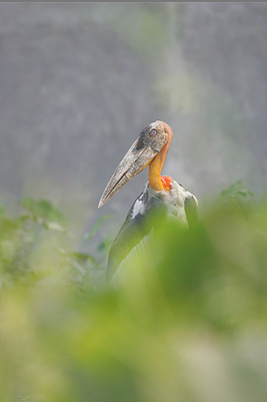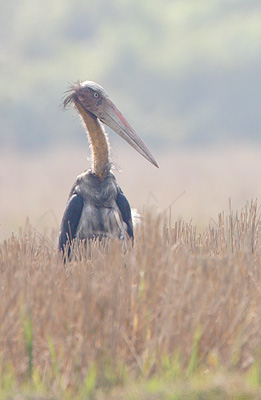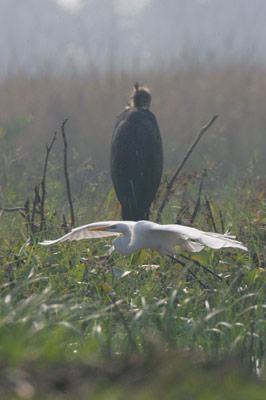
Meet The Adjutant Storks
©2006 Harri Vainola
©2006 Harri Vainola

In Assam, the far North-Eastern corner of India, lives one of the the largest and rarest of the storks, the Greater Adjutant Stork, together with it's smaller cousin, the Lesser Adjutant. These are endangered species; only a thousand Greater Adjutants, and 5000 Lesser Adjutants are left, and the populations are declining.
As I planned my Indian journey, finding these remarkable birds was high on my agenda,
as long as I could meet them without causing disturbance.
The last remaining major nesting sites for Greater Adjutant lay in Assam and Cambodia; they are all but gone from their previous stronghold of Myanmar. The Lesser Adjutant lives in much broader area, from India to Indonesia, but is not common anywhere. As so many other wetland species, both have greatly suffered from disappearance of their natural habitats.
The Greater Adjutant is said to be a shy and retiring bird on remote locations, but is much less so near cities. The species is essentially a scavenger, although they do catch some live pray also, as they sway their great beak from side to side in the water, much like an enormous spoonbill. This scavenging habit brings them in numbers close to human habitats, particularly outside the nesting season, and it is these 'city adjutants', that can be photographed without too much stress for the birds, as they are more custom to human presence.
The Greater Adjutant, Leptoptilos dubius, must be one of the most striking-looking birds in the world; it is an enormous stork, standing up to 1,5 m (five feet) tall, and it's mighty beak gives it strangely human proportions; an Adjutant standing on a distant rice paddy on a misty morning, can be mistaken for a human.
This is not that apparent from the photographs, but on two occasions, my local guide dismissed a distant Adjutant as a farmer!
I was spellbound from the first time I saw this giant bird up close; I find they have a special aura around them, as they stand there quietly, unlike any creature I have seen. Despite of their imposing size, they come off as gentle beings, living in harmony with their fellow beings.
It has been reported, that they sometimes steal food from other birds, being scavengers; I saw no evidence of such behaviour. In fact, the Greater Adjutants appeared to me as one of the least aggressive large carnivores I have seen; in no occasion, did they make an effort to take food from the much smaller birds, walking just in front of them. Other birds did not appear to see them as a threat, either; I watched a Little Egret stand happily hunting, practically straight under an Adjutant's beak. It didn't seem to occur to the Egret at all, that it would have been a beak-sized breakfast for the Adjutant.
As I planned my Indian journey, finding these remarkable birds was high on my agenda,
as long as I could meet them without causing disturbance.
The last remaining major nesting sites for Greater Adjutant lay in Assam and Cambodia; they are all but gone from their previous stronghold of Myanmar. The Lesser Adjutant lives in much broader area, from India to Indonesia, but is not common anywhere. As so many other wetland species, both have greatly suffered from disappearance of their natural habitats.
The Greater Adjutant is said to be a shy and retiring bird on remote locations, but is much less so near cities. The species is essentially a scavenger, although they do catch some live pray also, as they sway their great beak from side to side in the water, much like an enormous spoonbill. This scavenging habit brings them in numbers close to human habitats, particularly outside the nesting season, and it is these 'city adjutants', that can be photographed without too much stress for the birds, as they are more custom to human presence.
The Greater Adjutant, Leptoptilos dubius, must be one of the most striking-looking birds in the world; it is an enormous stork, standing up to 1,5 m (five feet) tall, and it's mighty beak gives it strangely human proportions; an Adjutant standing on a distant rice paddy on a misty morning, can be mistaken for a human.
This is not that apparent from the photographs, but on two occasions, my local guide dismissed a distant Adjutant as a farmer!
I was spellbound from the first time I saw this giant bird up close; I find they have a special aura around them, as they stand there quietly, unlike any creature I have seen. Despite of their imposing size, they come off as gentle beings, living in harmony with their fellow beings.
It has been reported, that they sometimes steal food from other birds, being scavengers; I saw no evidence of such behaviour. In fact, the Greater Adjutants appeared to me as one of the least aggressive large carnivores I have seen; in no occasion, did they make an effort to take food from the much smaller birds, walking just in front of them. Other birds did not appear to see them as a threat, either; I watched a Little Egret stand happily hunting, practically straight under an Adjutant's beak. It didn't seem to occur to the Egret at all, that it would have been a beak-sized breakfast for the Adjutant.
GREATER ADJUTANTS BY BURNING REFUSE. Compare their size to the foreground House Crows.
How to identify a Lesser Adjutant: Top of the head is white, and most birds tend to have much more neck-hair than the Greater Adjutants. Breeding birds are said to have red color in the beak area; the birds I saw, all had a pink, rather that red, stripe along their upper beak (the bird in the nest-image also has this, but it's rather weak).
The Lesser Adjutant, Leptoptilos javanicus, is not a scavenger, but a bird of prey; the menu consists mainly of fish, frogs, and reptiles, even snakes. They don't congregate near cities in the scale the Greater Adjutants often do; some birds are seen, though.
As I was searching the countryside with a guide, we came to large tree near a private farm; high up in the canopy, an unmistakable figure of an Adjutant was seen on a nest.
I was standing on a small road with some light traffic, so I felt, that I was not harassing the bird. As I took a closer look with a camera, a group of farmers came to work on the field; one walked right underneath the tree, and the bird did not seem to notice the farmer in any way; obviously she was used to them.
Encouraged by this, I lowered myself to the field, and took some photographs; not much of a shot, but it was, after all, a Lesser Adjutant at home; this would not come across too often. I sat on a roadside for a good while, looking through a long lens; she (I presume she was a she) looked ever so happy, while tending her young.
The Lesser Adjutant, Leptoptilos javanicus, is not a scavenger, but a bird of prey; the menu consists mainly of fish, frogs, and reptiles, even snakes. They don't congregate near cities in the scale the Greater Adjutants often do; some birds are seen, though.
As I was searching the countryside with a guide, we came to large tree near a private farm; high up in the canopy, an unmistakable figure of an Adjutant was seen on a nest.
I was standing on a small road with some light traffic, so I felt, that I was not harassing the bird. As I took a closer look with a camera, a group of farmers came to work on the field; one walked right underneath the tree, and the bird did not seem to notice the farmer in any way; obviously she was used to them.
Encouraged by this, I lowered myself to the field, and took some photographs; not much of a shot, but it was, after all, a Lesser Adjutant at home; this would not come across too often. I sat on a roadside for a good while, looking through a long lens; she (I presume she was a she) looked ever so happy, while tending her young.
LESSER ADJUTANT ON SUNNY FIELD
Identifying such conspicuous birds should not be difficult! These two species are so rare, though, that they are sometimes misidentified. The Greater Adjutant is, of course, the larger of the two; Lesser Adjutant is not much taller than a White Stork.
How to identify a Greater Adjutant: A large, hanging, orange chest-pouch is the most famous feature of an adult bird; in some birds, though, this pouch is either partly, or totally hidden behind the chest-feathers. For example, the bird in the Meet Greater Adjutant-photo doesn't appear to have a pouch; after he stepped to the full view, though, a lower part of the pouch could be seen peaking behind the chest feathers. You may notice a parting in the Greater Adjutant's feathers at this position, if you look closely. They also have an equally bright neck-pouch.
The beak is wider than the Lesser Adjutant's, and it has a dark area in front of the eyes.
The overall plumage color is dark bluish grey; Lesser Adjutants are more black.
Juvenile birds have hairier beaks and necks, and they tend to have less light patches
on their wings.
How to identify a Greater Adjutant: A large, hanging, orange chest-pouch is the most famous feature of an adult bird; in some birds, though, this pouch is either partly, or totally hidden behind the chest-feathers. For example, the bird in the Meet Greater Adjutant-photo doesn't appear to have a pouch; after he stepped to the full view, though, a lower part of the pouch could be seen peaking behind the chest feathers. You may notice a parting in the Greater Adjutant's feathers at this position, if you look closely. They also have an equally bright neck-pouch.
The beak is wider than the Lesser Adjutant's, and it has a dark area in front of the eyes.
The overall plumage color is dark bluish grey; Lesser Adjutants are more black.
Juvenile birds have hairier beaks and necks, and they tend to have less light patches
on their wings.
THE SENTINEL
Later on a day, as we strolled past the site again, I also briefly saw her spouse, as he was leaving the nest, having provided a much-welcomed meal for the family.
I was told, that at least this nesting-tree was protected by the government; so there is a good chance, that the little one on the photograph above, has safely grown up to join the far too few-numbered Adjutants of Northern India.
Good luck for the young one.
I was told, that at least this nesting-tree was protected by the government; so there is a good chance, that the little one on the photograph above, has safely grown up to join the far too few-numbered Adjutants of Northern India.
Good luck for the young one.





